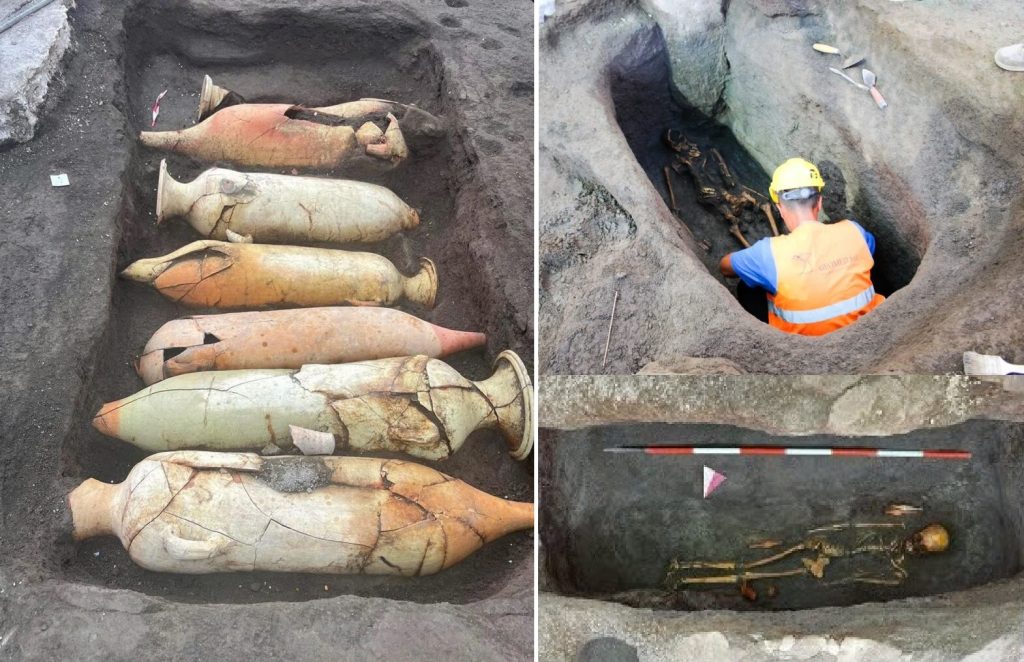Archaeological excavations in the shadow of Mount Vesuvius continue to uncover astonishing revelations about the ancient world, and the latest discoveries near the iconic ruins of Pompeii have provided a remarkable window into life before the Roman era. As someone who has spent 50 years delving into the mysteries of antiquity, I find these findings not only compelling but invaluable for understanding the roots of Mediterranean civilization. Unearthed during construction work for an underground parking facility, these discoveries have shed light on a thriving culture that predates Roman Pompeii and offers new perspectives on trade, burial customs, and agricultural practices in ancient Italy.

One of the most fascinating finds from this site is a necropolis that appears almost frozen in time. This burial ground contains 35 pre-Roman earthen pit graves, each covered meticulously with amphorae—ceramic vessels used widely in antiquity for transporting liquids like wine and oil. These amphorae were carefully arranged with alternating neck and tip placements, a ritualistic pattern that likely held symbolic or cultural meaning for the people who conducted these burials. Dating from the 3rd to 1st century BC, these graves provide direct insight into funerary traditions before Roman influence took hold in the region. What adds another layer of intrigue is the presence of makers’ marks in the Punic language etched into the amphorae, strongly suggesting they originated from North Africa. This detail points to an active and far-reaching trade network, illustrating that even before Roman dominance, this region was a hub of international commerce and cultural exchange.
The preservation of human remains within this necropolis is exceptional, largely due to anaerobic conditions created by the region’s high groundwater levels. Such environments slow down decomposition, allowing archaeologists to recover skeletal remains in a condition rarely seen in sites of similar age. This level of preservation allows for detailed analysis of diet, health, and lifestyle. In addition to the skeletons, researchers found unguentarians—small ceramic vessels used to hold perfumes or oils—and coins placed with the deceased, shedding light on burial rites and the spiritual or cultural beliefs surrounding death in this society. These funerary objects, humble yet rich with meaning, provide clues about the personal lives of the people buried here, their beliefs about the afterlife, and their material culture.
Adjacent to the burial site, a canal has proven to be a veritable treasure trove of ancient artifacts. Likely disturbed by earlier burial activity or later natural events, this waterway has yielded an array of objects, each with its own story. Archaeologists have recovered hundreds of tile fragments, sections of preserved wood, amphorae, and dolia—massive earthenware jars used for the storage and transport of agricultural goods. Particularly fascinating are 20 small columella, stone markers made from volcanic rock, which may have served as tomb markers or property boundaries. Adding to the linguistic puzzle are tiles stamped in the Oscan language, an extinct Italic language once spoken in the region before Latin took hold. The discovery of a carved stone head made of Campanian tufa—a soft volcanic stone native to the area—adds an artistic dimension. The head still bears traces of red paint, a rare find that suggests how ancient artisans once brought their sculptures vividly to life.
Beneath layers of pumice stone deposited by Vesuvius’ catastrophic eruption in 79 AD, archaeologists have also unearthed an ancient agricultural system that supplied Pompeii with food before its destruction. This field system, now visible through the remnants of furrows and planting pits, indicates a sophisticated level of farming. The discovery of organic matter, including seeds and pollen, is under active study to determine the types of crops cultivated. Preliminary evidence points to the cultivation of perennial vegetables, with early findings suggesting that artichokes—a plant prized for both its taste and medicinal properties—may have been a specialty of the region. This discovery underscores the importance of local agriculture in sustaining Pompeii’s population and economy.
These groundbreaking finds offer a rare and vivid glimpse into life in Italy before Roman dominance. They highlight the rich tapestry of cultural influences, from North Africa to local Italic tribes, that shaped the area long before Latin became the lingua franca and Rome established its empire. The burial customs, agricultural ingenuity, and evidence of trade all serve to paint a more complex and nuanced picture of pre-Roman Pompeii—a city not yet immortalized by volcanic ash but already flourishing in its own right.
As these excavations progress, they not only expand our understanding of Pompeii’s early history but also challenge long-held assumptions about the development of civilization in southern Italy. They remind us that history is not a linear progression but a mosaic of overlapping cultures, technologies, and human experiences. The people who lived and died in pre-Roman Pompeii left behind more than ruins—they left stories waiting to be told, and it is our duty as archaeologists and scholars to bring those stories to light.
In closing, these discoveries reaffirm the power of archaeology to connect us with the distant past. They serve as a humbling reminder that beneath our modern cities lie the echoes of ancient lives, cultures, and mysteries, still waiting to be unearthed. And in every amphora, coin, or carved stone, there is a thread that links us to the people who once called this land home. As we continue to dig, study, and interpret, who knows what other secrets this storied land may yet reveal about the civilizations that once thrived in the fertile lands surrounding Vesuvius.





